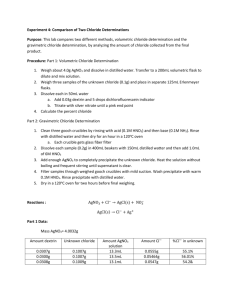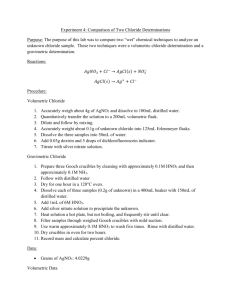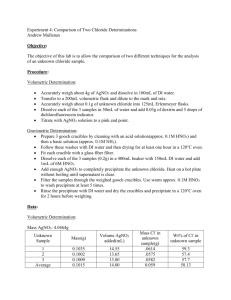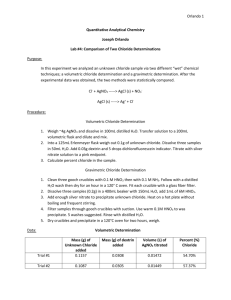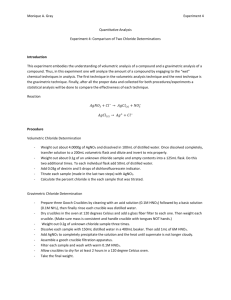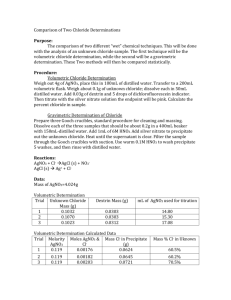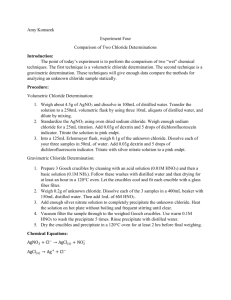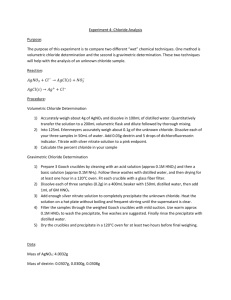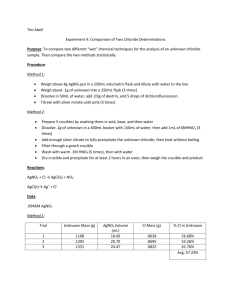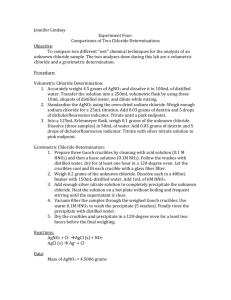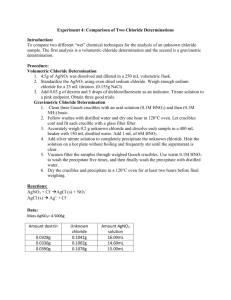lab four
advertisement
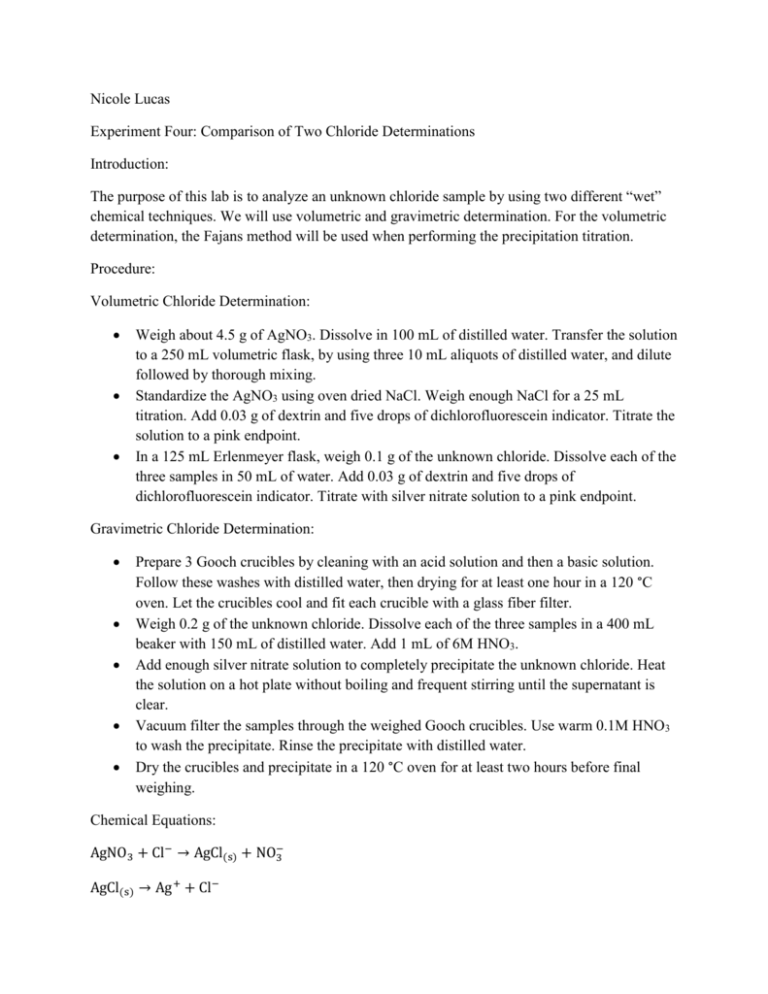
Nicole Lucas Experiment Four: Comparison of Two Chloride Determinations Introduction: The purpose of this lab is to analyze an unknown chloride sample by using two different “wet” chemical techniques. We will use volumetric and gravimetric determination. For the volumetric determination, the Fajans method will be used when performing the precipitation titration. Procedure: Volumetric Chloride Determination: Weigh about 4.5 g of AgNO3. Dissolve in 100 mL of distilled water. Transfer the solution to a 250 mL volumetric flask, by using three 10 mL aliquots of distilled water, and dilute followed by thorough mixing. Standardize the AgNO3 using oven dried NaCl. Weigh enough NaCl for a 25 mL titration. Add 0.03 g of dextrin and five drops of dichlorofluorescein indicator. Titrate the solution to a pink endpoint. In a 125 mL Erlenmeyer flask, weigh 0.1 g of the unknown chloride. Dissolve each of the three samples in 50 mL of water. Add 0.03 g of dextrin and five drops of dichlorofluorescein indicator. Titrate with silver nitrate solution to a pink endpoint. Gravimetric Chloride Determination: Prepare 3 Gooch crucibles by cleaning with an acid solution and then a basic solution. Follow these washes with distilled water, then drying for at least one hour in a 120 °C oven. Let the crucibles cool and fit each crucible with a glass fiber filter. Weigh 0.2 g of the unknown chloride. Dissolve each of the three samples in a 400 mL beaker with 150 mL of distilled water. Add 1 mL of 6M HNO3. Add enough silver nitrate solution to completely precipitate the unknown chloride. Heat the solution on a hot plate without boiling and frequent stirring until the supernatant is clear. Vacuum filter the samples through the weighed Gooch crucibles. Use warm 0.1M HNO3 to wash the precipitate. Rinse the precipitate with distilled water. Dry the crucibles and precipitate in a 120 °C oven for at least two hours before final weighing. Chemical Equations: AgNO3 + Cl− → AgCl(s) + NO− 3 AgCl(s) → Ag + + Cl− Data: Volumetric Determination (Mass of AgNO3:4.5084g): Sample 1 Sample 2 Sample 3 Unknown Cl Dextrin (g) (g) 0.1011 0.0334 0.1085 0.0333 0.1062 0.0303 AgNO3(mL) Cl- (g) % Cl 15.48 16.09 15.89 57.57 55.66 56.21 0.0582 0.0604 0.0597 Mass of NaCl used in titration : 0.1518 g Mass Dextrin - 0.0324 g Gravimetric Determination: Sample 1 Sample 2 Sample 3 Initial Crucible Mass 23.3684 22.6249 23.0140 (g) Final Crucible Mass 23.8323 23.1024 23.4857 (g) Product Mass (g) 0.4639 0.4775 0.4717 Unknown Chloride 0.2067 0.2092 0.2066 (g) AgNO3 (mL) 35.00 35.00 35.00 Cl- mass (g) 0.114 0.118 0.117 % Cl 55.15 56.40 56.63 Amount of silver nitrate to completely precipitate chloride = 31.9 mL Volumetric % Gravimetric % Δ Percentage Mean Standard Deviation t calc Sample 1 57.57 55.15 2.42 1.19 1.07 1.92 Sample 2 55.66 56.40 0.74 Sample 3 56.210 56.63 0.42 Calculations: Volumetric Analysis: Mass NaCl: Finding grams of Chloride: Percent of Chloride: mass chloride ∗ 100 = percent chloride mass unknown 0.0597g Cl 0.1062g Unknown ∗ 100 = 56.21% Cl- Gravimetric Analysis: Mass of AgCl: Final Crucible Mass – Initial crucible Mass = Mass of AgCl 23.8323 g – 23.3684 g = 0.4639 g AgCl Volume of AgNO3 solution to be used: g Unknown * %Cl- = gCl 0.2 g Unknown * 0.5621 Cl- = 0.112 g Cl Mass of Chloride: Percent of Chloride: % ClAverage: X1+X2+…+Xn / n 2.42+0.74+0.42 / 3 = 1.19 Standard Deviation: ∑(Xi − ̅ X)2 √ n−1 (2.42−1.19)2 +(0.74−1.19)2 +(0.42−1.19)2 √ 2 tcalc : ̅| |X ∗ √n s |1.19| 1.07 ∗ √3 = 1.92 = 1.07 Conclusion: This experiment was designed to show the consistency between two different methods applied to the same sample of unknown chloride. After comparing our results with the student’s t, the methods were compatible within the 90% confidence interval. Our tcalc, 1.92, was less than the given value of 2.920. The 90% confidence interval is a large area that the data could be distributed under. Our value was inbetween the 50% and 90% confidence interval. If more than three samples were conducted, a more accurate value for the tcalc could have been determined. We could know then if our value falls more towards the 50% confidence interval or the 90% confidence interval. The gravimetric determination was the most accurate method for this experiment. The chloride masses were significantly larger and more precise for the gravimetric determination than the volumetric determination. We performed an indirect gravimetric analysis experiment and a direct titration for the volumetric portion.
